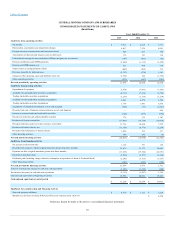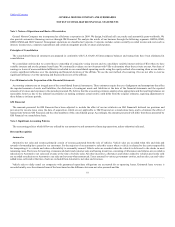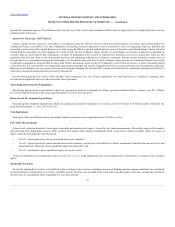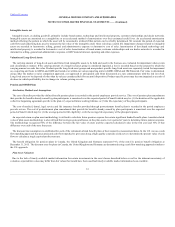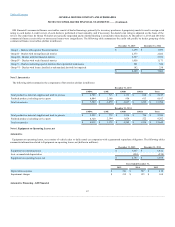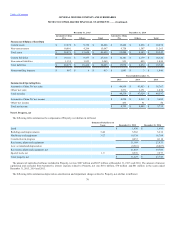General Motors 2015 Annual Report Download - page 66
Download and view the complete annual report
Please find page 66 of the 2015 General Motors annual report below. You can navigate through the pages in the report by either clicking on the pages listed below, or by using the keyword search tool below to find specific information within the annual report.
Table of Contents
Common and Preferred Stock
Common and preferred stock for which market prices are readily available at the measurement date are valued at the last reported sale price or official
closing price on the primary market or exchange on which they are actively traded and are classified in Level 1. Such equity securities for which the market is
not considered to be active are valued via the use of observable inputs, which may include, among others, the use of adjusted market prices last available,
bids or last available sales prices and/or other observable inputs and are classified in Level 2. Common and preferred stock classified in Level 3 are those
privately issued securities or other issues that are valued via the use of valuation models using significant unobservable inputs that generally consider among
others, aged (stale) pricing, earnings multiples, discounted cash flows and/or other qualitative and quantitative factors.
Debt Securities
Valuations for debt securities are based on quotations received from independent pricing services or from dealers who make markets in such securities.
Debt securities priced via pricing services that utilize matrix pricing which considers readily observable inputs such as the yield or price of bonds of
comparable quality, coupon, maturity and type as well as dealer supplied prices, are classified in Level 2. Debt securities within this category that are
typically priced by dealers and pricing services via the use of proprietary pricing models which incorporate significant unobservable inputs are classified in
Level 3. These inputs primarily consist of yield and credit spread assumptions, discount rates, prepayment curves, default assumptions and recovery rates.
Investment Funds, Private Equity and Debt Investments and Real Estate Investments
Investment funds, private equity and debt investments and real estate investments are valued based on the Net Asset Value (NAV) per Share (or its
equivalent) as a practical expedient to estimate fair value due to the absence of readily available market prices.
NAV's are provided by the respective investment sponsors or investment advisers and are subsequently reviewed and approved by management. In the
event management concludes a reported NAV does not reflect fair value or is not determined as of the financial reporting measurement date, we will consider
whether and when deemed necessary to make an adjustment at the balance sheet date. In determining whether an adjustment to the external valuation is
required, we will review material factors that could affect the valuation, such as changes to the composition or performance of the underlying investments or
comparable investments, overall market conditions, expected sale prices for private investments which are probable of being sold in the short-term and other
economic factors that may possibly have a favorable or unfavorable effect on the reported external valuation.
We provide extended disability benefits for employees currently disabled and those in the active workforce who may become disabled in the form of
income replacement, healthcare costs and life insurance premiums. We recognize a liability for extended disability benefits over the expected service period
using measurement provisions similar to those used to measure our OPEB obligations based on our best estimate of the probable liability at the measurement
date. We record actuarial gains and losses immediately in earnings.
Our stock incentive plans include RSUs, Performance Share Units (PSUs), stock options and salary stock. We measure and record compensation expense
based on the fair value of our common stock on the date of grant for RSUs and PSUs and the grant date fair value of stock options determined utilizing a
lattice model or the Black-Scholes-Merton formula. Compensation cost for awards that do not have an established accounting grant date is based on the fair
value of our common stock at the end of each reporting period. We record compensation cost for RSUs and PSUs on a straight-line basis over the entire
vesting period, or for retirement eligible employees over the requisite service period. We use the graded vesting method to record compensation cost for stock
options over the lesser of the vesting period or the time period an employee becomes eligible to retain the award at retirement. Salary stock awards are fully
vested and nonforfeitable upon grant; therefore, compensation cost is recorded on the date of grant. The liability for stock incentive plan awards settled in
cash is remeasured to fair value at the end of each reporting period.
62





